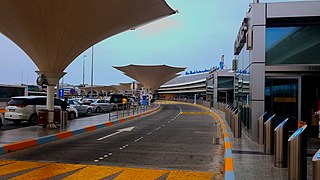
An aviation accident is defined by the Convention on International Civil Aviation Annex 13 as an occurrence associated with the operation of an aircraft, which takes place from the time any person boards the aircraft with the intention of flight until all such persons have disembarked, and in which (a) a person is fatally or seriously injured, (b) the aircraft sustains significant damage or structural failure, or (c) the aircraft goes missing or becomes completely inaccessible. Annex 13 defines an aviation incident as an occurrence, other than an accident, associated with the operation of an aircraft that affects or could affect the safety of operation.
Pakistan International Airlines is an international airline that serves as the flag carrier of Pakistan under the administrative control of the Secretary to the Government of Pakistan for Aviation. Its central hub is Karachi's Jinnah International Airport, while Allama Iqbal International Airport in Lahore and Islamabad International Airport serve as secondary hubs.
This is a list of aviation-related events from 1980.
This is a list of aviation-related events from 1985.

Gulf Air is the state-owned airline and the flag carrier of Bahrain, which was founded in 1950 by British pilot Freddie Bosworth as Gulf Aviation. Headquartered in Muharraq, the airline operates scheduled flights to 59 destinations in 28 countries across Africa, Asia, and Europe. The airline's main hub is Bahrain International Airport.

Sheikh Zayed International Airport is an international airport in the Emirate of Abu Dhabi, the capital of the United Arab Emirates.
This is a list of aviation-related events from 1972.
This is a list of aviation-related events from 1974.
This is a list of aviation-related events from 1976.

Gulf Air Flight 072 (GF072/GFA072) was a scheduled international passenger flight from Cairo International Airport in Egypt to Bahrain International Airport in Bahrain, operated by Gulf Air. On 23 August 2000 at 19:30 Arabia Standard Time (UTC+3), the Airbus A320 crashed minutes after executing a go-around upon failed attempt to land on Runway 12. The flight crew suffered from spatial disorientation during the go-around and crashed into the shallow waters of the Persian Gulf 2 km (1 nmi) from the airport. All 143 people on board the aircraft were killed.

Middle East Airlines Flight 438 was an international passenger flight operated by a Boeing 720 from Beirut, Lebanon, to Muscat, Oman, with a stopover in Abu Dhabi, United Arab Emirates. On 1 January 1976 the aircraft operating the flight was destroyed by a bomb, killing all 81 people on board. The bombers were never identified.

On September 8, 1974, a Boeing 707-331B operating as TWA Flight 841 from Tel Aviv to New York City via Athens and Rome crashed into the Ionian Sea, killing all aboard. The National Transportation Safety Board determined that the plane had been destroyed by a bomb hidden in the cargo hold. The detonation of the bomb destroyed the systems responsible for operating the plane's control surfaces, causing the plane to pitch up until it stalled and dove into the sea.

Alyemda, internationally known as Democratic Yemen Airlines or just Yemen Airlines, was the national airline of South Yemen. It was established at Aden on 11 March 1971 after nationalizing Brothers Air Services (BASCO) which was a private company owned by the Baharoon brothers. It operated a network of flight routes throughout Africa and the Middle East, with its hub at Aden Airport, the former Khormaksar Air Force Base. Its head office was in the Alyemda Building in Khormaksar, Aden.
Air France has been in operation since 1933. Its aircraft have been involved in a number of major accidents and incidents. The deadliest accident of the airline occurred on June 1, 2009, when Air France Flight 447, an Airbus A330-203, flying from Rio de Janeiro to Paris crashed into the Atlantic Ocean with 228 fatalities. A selected list of the most noteworthy of these events is given below.

Emirates Flight 521 (EK521/UAE521) was a scheduled international passenger flight from Thiruvananthapuram, India, to Dubai, United Arab Emirates, operated by Emirates using a Boeing 777-300. On 3 August 2016, the aircraft carrying 282 passengers and 18 crew crashed while landing at Dubai International Airport.








